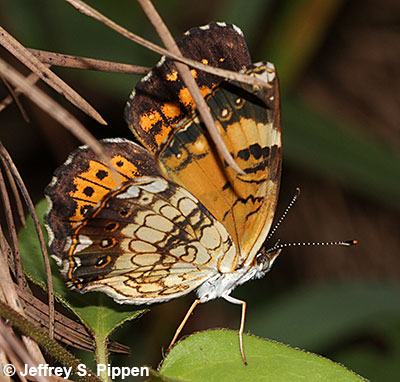

Hillsborough, Orange Co., NC
24 Aug 2017
Pictured here are two subspecies of Silvery Checkerspot, one from the NC mountains, and one from the piedmont. Note that the mountain subspecies C. n. pastoron, formerly called C. ismeria obsoleta or C. nycteis obsoleta) shows a greater amount of black, especially on the hindwing, and more "open, white-filled" submarginal hindwing spots. For Ron Gatrelle's original publication describing this taxon, see Vol 4 Number 4 of The Taxonomic Report. You can download a pdf of this paper here: http://www.tils-ttr.org/. Click on the Taxonomic Report, then select Volume 4. The name was recently changed by Pelham, 2008, A Cataglogue of the Butterflies of the United States and Canada due to name conflicts. Note that the new name proposed by Pelham (Chlosyne nycteis pastoron) commemorates Ron Gatrelle, who was a Pastor, and who originally named the taxon.
 |
 |
Silvery Checkerspot (Chlosyne nycteis nycteis) Hillsborough, Orange Co., NC 24 Aug 2017 |
 |
 |
Silvery Checkerspot (Chlosyne nycteis nycteis) Hillsborough, Orange Co., NC 19 Aug 2018 |
 |
 |
Silvery Checkerspot (Chlosyne nycteis nycteis) Brumley Nature Preserve, Orange Co., NC 4 May 2023 |
 |
 |
Silvery Checkerspot (Chlosyne nycteis nycteis) Mason Farm, Orange Co., NC 30 Aug 2023 |
 |
 |
Silvery Checkerspot (Chlosyne nycteis nycteis) Mason Farm, Orange Co., NC 30 Aug 2023 |
 |
|
| Silvery Checkerspot (Chlosyne nycteis nycteis) Hillsborough, Orange Co., NC 24 Aug 2017 |
 |
 |
| Silvery Checkerspot (Chlosyne nycteis pastoron), Female Clay Co., NC 14 May 2005 |
Silvery Checkerspot (Chlosyne nycteis pastoron) Clay Co., NC 22 May 2005 |
 |
Silvery Checkerspot (Chlosyne nycteis pastoron), Female Great Smoky Mountain National Park Swain Co., NC 4 July 2001 |
 |
 |
Side by side comparison of the 2 subspecies |
| Silvery Checkerspot (Chlosyne nycteis pastoron), Female Clay Co., NC 21 May 2005 |
Silvery Checkerspot (C. nycteis nycteis), Male Orange Co., NC 21 August 2004 | |
 |
 |
| Silvery Checkerspot (C. n. nycteis), Male Nectaring on Pycnanthemum tenuifolium Orange Co., NC 25 July 2003 |
Silvery Checkerspot (C. n. nycteis), Male Korstian Division of Duke Forest Orange Co., NC 5 May 2004 |
| These two individuals are atypical for subspecies nycteis in that the two hindwing orange bands are different shades. | |
 |
 |
| Silvery Checkerspot (C. n. nycteis), Male Korstian Division of Duke Forest Orange Co., NC 5 May 2004 |
Silvery Checkerspot (C. n. nycteis), Female Orange Co., NC 20 July 2005 |
 |
 |
| Silvery Checkerspot (C. n. nycteis), Female Orange Co., NC 20 July 2005 |
Silvery Checkerspot (C. n. nycteis), Female Orange Co., NC 20 July 2005 |
 |
 |
| Silvery Checkerspot (C. n. nycteis), Male Orange Co., NC 20 July 2005 |
Silvery Checkerspot (C. n. nycteis), Male Orange Co., NC 20 July 2005 |
Regarding the undersides of these two subspecies (compare photo on page top-right (obsoleta) with all other underside shots above (nycteis)), Ron Gatrelle notes, "The one underside of obsoleta (very top right of page) has a lot more white crescent marks on the outer edge of the HW, and more white in the middle of the wing. Obsoleta gets its name from less fulvous above and less dark below then nycteis. So most obsoleta will be darker above but lighter below. This is very pronounced in some specimens - of both subspecies. It's like having a strip of white and a strip of black and then overlapping them by 1/8 which yields a gray. 80% of each subspecies should be clearly referable to each. But the one extreme end of one will be similar or like the extreme end of the other.
 |
|
| Silvery Checkerspot (Chlosyne nycteis) Wilkes Co., NC 24 Aug 2016 |
 |
 |
Silvery Checkerspot (Chlosyne nycteis nycteis) Sam Houston WMA, Walker Co., TX 1 Apr 2018 |
 |
 |
Silvery Checkerspot (Chlosyne nycteis nycteis) Sam Houston WMA, Walker Co., TX 1 Apr 2018 |
 |
Silvery Checkerspot (Chlosyne nycteis) caterpillar Harnett Co., NC 21 may 2006 |
 |
Silvery Checkerspot (Chlosyne nycteis) caterpillar Clay Co., NC 19 May 2007 |
 |
Silvery Checkerspot (Chlosyne nycteis) caterpillar Clay Co., NC 19 May 2007 |
Created on ... July 17, 2001 | jeffpippen9@gmail.com